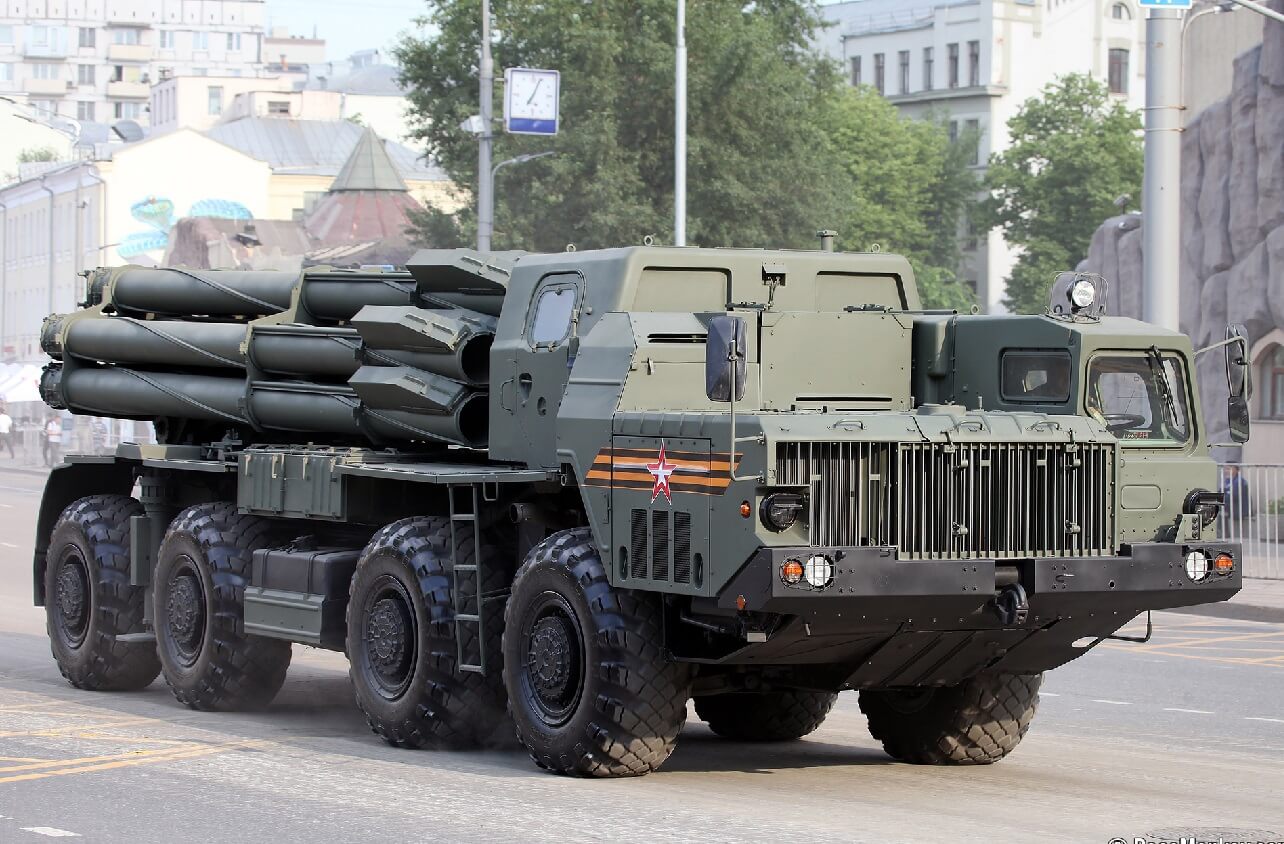Russia continues to rain short-range ‘Iskander’ ballistic missiles on Ukrainian targets. But, now, state arms manufacturer Rostec has realized the Tornado-S multiple launch rocket system (MLRS) is a cost-effective and ideal option for destroying such low-value targets.
4th Country With Hypersonic Tech, Expert Calls Iran’s Fattah-2 As Uninterceptable Cruise Missile Ideal For Preemptive Strikes
Bekhan Ozdoyev, Industrial Director of the Rostec complex of conventional weapons, munitions, and special chemical compounds, announced that owing to the increased range of its munitions, the Tornado-S multiple launch rocket system (MLRS) can be used to destroy targets where using Iskander tactical missiles would be excessive, TASS News Agency reported.
He emphasized that the Tornado-S MLRS can target both large areas and individual targets via its high-precision munitions. He assured, “We will continue developing these systems,” adding that the Tornado-S is now closer to the tactical missile system class owing to the new guided rocket-propelled bombs’ improved range of 90 to 120 kilometers.
“These munitions could be used to destroy targets, where using the Iskanders would be excessive. The accuracy of the Tornado-S is very high, and the warhead’s power is enough to hit almost any, even a serious protected facility,” Ozdoyev said.
The statement comes amid reports that Russian forces have intensified the use of Iskander missiles. A new pattern of Russian attacks suggests that when Ukrainian soldiers gather at a “hit site” for rescue operations, Russia fires multiple Iskanders at the exact location to inflict higher casualties.
The strategy has taken the Ukrainians by surprise because they are accustomed to anticipating only one Iskander attack, which gives them time to adjust their battlefield positioning.
However, launching a swift attack after deciding to take defensive action has increased casualties and stunned people. This has also somewhat challenged the rumors that Russia was facing a shortfall of Iskander missiles.

However, in a more recent development, some Russian Telegram groups, claiming personal and familial ties to the defense and military sectors, have observed that Russia is now readily able to deploy Iskander missiles because its manufacturers have successfully ramped up production and are not negatively impacted by sanctions from the West.
EurAsian Times could not corroborate these claims.
Iskander mobile short-range ballistic missiles are battlefield tactical missiles, including some cruise missile variants, that have ranges of around 500 kilometers. “The missile warhead can destroy enemy command posts, the convoy of equipment, and air defense systems,” according to the Russian Ministry of Defense (RuMoD).
There is no information on why Russia would consider replacing the Iskander ballistic missiles with the Tornado-S MLRS. However, military watchers of the Ukraine War said if such a decision is taken, it may be to reserve the Iskander for hitting specific, high-value targets because the production of these missiles takes several components procured from the West.
Earlier this year, Vadym Skibitskyi, the head of the Main Intelligence Directorate of the Ukrainian Ministry of Defense, told reporters that Russia currently has fewer than 200 Iskanders missiles and was attempting to preserve them by launching outdated S-300 missiles at Ukraine instead.
“With the US going on a new sanction spree, it may become more difficult for Russia to obtain these components from third countries. So, it would make sense why they do things like use rocket artillery more or curtail the export of Lancet UAVs,” a military observer who didn’t want to be named told EurAsian Times.
Russia’s Tornado-S is an analog of the American HIMARS deployed by Ukraine, a Multiple Launch Rocket System used to strike targets inside the enemy territories. In November last year, some Russian military analysts told the media that Moscow was ramping up production of the Tornado-S MLRS.
It may then be possible that Russian officials are contemplating replacing Iskander missiles for targets well within the reach of the Tornado-S MLRS.
Russia Is Transforming Tornado-S MLRS And How!
Ozdoyev revealed to TASS that robotic vehicles might be constructed from Smerch and Tornado-S multiple launch rocket systems (MLRS).
“Today, we can create the best armaments in the world, which include Smerch and its modifications. They are unrivaled by firepower, reliability, and other characteristics. The modernization potential has not been exhausted.
“In the future, Smerch and Tornado-S can be developed into new-generation MLRS, including robotic ones, according to the experience of the special military operation. It means Smerch 300mm successors will be the most powerful MLRS in the Russian army,” he said.
Rostec Deputy General Director Vladimir Artyakov said earlier this month that a host of weapon systems had seen an uptick in demand from global customers owing to their performance in the ‘Special Military Operation’ zone. The Tornado-S MLRS is one of the many items on that list. Russia has been marketing the system to foreign customers, especially in the Middle East, as previously reported by EurAsian Times.
Tornado-S has 12 guides for 300mm rocket-propelled projectiles. The 300-millimeter caliber MLRS Tornado-S, also known as 9K515 “Tornado-S,” is a significant upgrade to the “Smerch” system. The weapon system has onboard control and communication systems and an automated guidance and fire control system.
The Tornado-S uses a brand-new guidance and fire control system (ASUNO) with several key enhancements. It has improved target designation, data exchange capabilities, and quicker and more precise estimates of aiming angles and other attributes. Technology for feeding data into missile homing heads has also been developed.
The Russian manufacturer considering a conversion of the Tornado-S MLRS into a robotic vehicle hints at the country focusing on artificial intelligence and autonomy as the war grinds on and the battlefield constantly sees technological innovation.
- Contact the author at sakshi.tiwari9555 (at) gmail.com
- Follow EurAsian Times on Google News